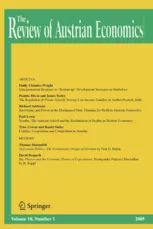- | Academic & Student Programs Academic & Student Programs
- | Financial Markets Financial Markets
- | Journal Articles Journal Articles
- |
Monetary Equilibrium and Price Stickiness Reconsidered: A Reply to Bagus and Howden
Originally published in The Review of Austrian Economics
Bagus and Howden argue that price stickiness is a poor justification for advocating a flexible money supply through the issuing of fiduciary media under central or free banking. We show that even if all prices were perfectly flexible, changes in the money supply to offset changes in money demand might still be desirable.

Bagus and Howden (Review of Austrian Economics 24(4): 383–402, 2011) argue that price stickiness is a poor justification for advocating a flexible money supply through the issuing of fiduciary media under central or free banking. They view the contraction in output following an exogenous increase in money demand as an optimal response, worry about redistribution effects from the issuance of fiduciary media, and claim a changing money supply complicates economic calculation. Accepting their view that the contraction in output is an optimal response to an exogenous change in money demand, we still find a potentially beneficial role for monetary policy (under central banking) or fractional reserve note issue (under free banking). We show that even if all prices were perfectly flexible, changes in the money supply to offset changes in money demand might still be desirable. We point out several errors and mischaracterizations in their article, justify our decision to disregard wealth transfers, and discuss how a flexible money supply might facilitate economic calculation.
Find the paper at SpringerLink.
To speak with a scholar or learn more on this topic, visit our contact page.

